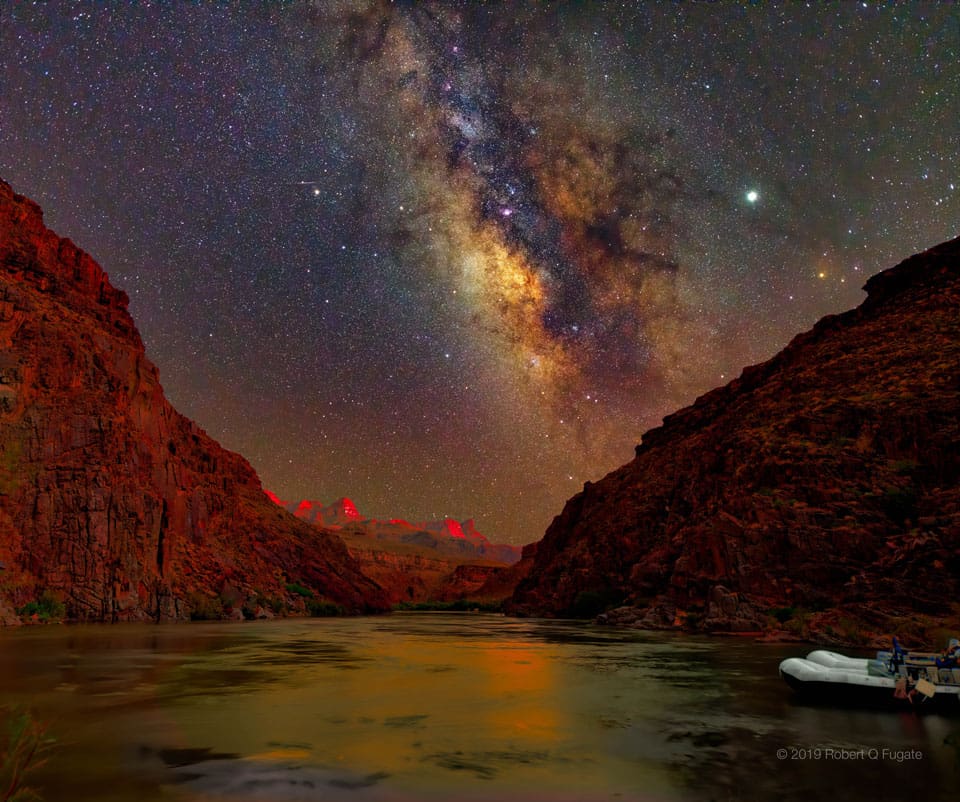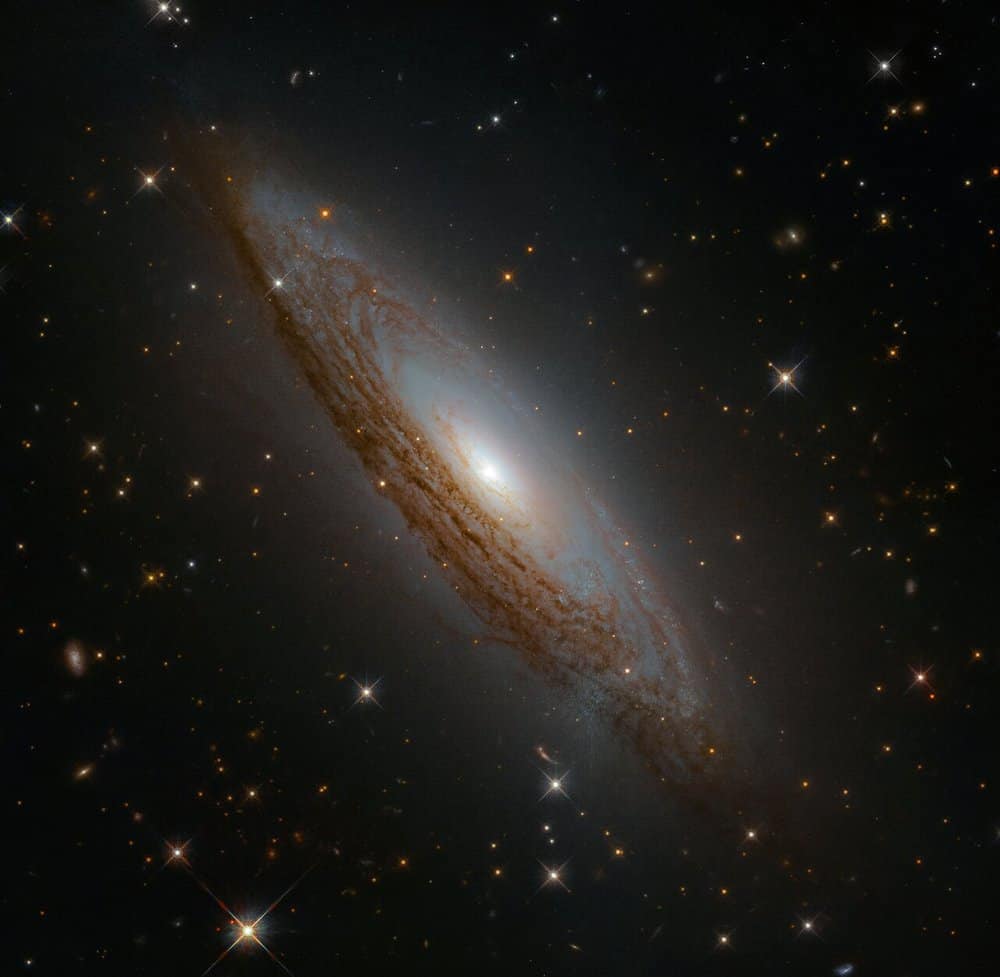Blog
John Pisano (born February 6, 1931) is a jazz guitarist born in Staten Island, New York.
Pisano has worked with Herb Alpert, Billy Bean, Chico Hamilton, Peggy Lee, and Joe Pass.
more...An international team of astronomers led by scientists at the University of California, Riverside, has found an unusual monster galaxy that existed about 12 billion years ago, when the universe was only 1.8 billion years old.
Dubbed XMM-2599, the galaxy formed stars at a high rate and then died. Why it suddenly stopped forming stars is unclear.
“Even before the universe was 2 billion years old, XMM-2599 had already formed a mass of more than 300 billion suns, making it an ultramassive galaxy,” said Benjamin Forrest, a postdoctoral researcher in the UC Riverside Department of Physics and Astronomy and the study’s lead author. “More remarkably, we show that XMM-2599 formed most of its stars in a huge frenzy when the universe was less than 1 billion years old, and then became inactive by the time the universe was only 1.8 billion years old.”
The team used spectroscopic observations from the W. M. Keck Observatory’s powerful Multi-Object Spectrograph for Infrared Exploration, or MOSFIRE, to make detailed measurements of XMM-2599 and precisely quantify its distance.

Al Kooper (born Alan Peter Kuperschmidt, February 5, 1944) is an American songwriter, record producer and musician, known for organizing Blood, Sweat & Tears, although he did not stay with the group long enough to share its popularity. Throughout much of the 1960s and 1970s, he was a prolific studio musician, playing organ on the Bob Dylan song “Like A Rolling Stone“, French horn on the Rolling Stones song “You Can’t Always Get What You Want“, and lead guitar on Rita Coolidge‘s “The Lady’s Not for Sale“, among many other appearances. He also produced a number of one-off collaboration albums, such as the Super Session album that brought together guitarists Mike Bloomfield and Stephen Stills. In the 1970s he was a successful manager and producer, notably recording Lynyrd Skynyrd‘s first three albums. He has also had a successful solo career, written music for film soundtracks, and has lectured in musical composition. He continues to perform live.
Kooper, born in Brooklyn, to Sam and Natalie Kooper and grew up in a Jewish family in Hollis Hills, Queens, New York.
more...Richard Quentin Laird (born 5 February 1941) is an Irish bassist who is best known for his place in the American jazz fusion band Mahavishnu Orchestra.
Born in Dublin, Ireland, Laird played music from a young age and enrolled for guitar and piano lessons. He started playing jazz after moving to New Zealand at the age of 16 with his father. He played guitar in jam bands in New Zealand before buying an upright bass. After extensive touring in New Zealand he moved to Sydney, Australia, where he played with many top jazz musicians including Don Burrows.
He moved to England in 1962 and became house bassist at Ronnie Scott’s Jazz Club in London, playing with many greats including the guitarist Wes Montgomery and Sonny Stitt and even with Buddy Rich, most notably the residence at The Talk of the Town in 1969. From 1963 to 1964 Laird was at London’s Guildhall School of Music and Drama. He was recorded on Sonny Rollins‘s record Alfie and played in The Brian Auger Trinity (July 1963-February 1964) and The Brian Auger Group (February–October 1964).
His next step was to go to Berklee College of Music in Boston, US, where he studied arranging, composition and string bass. He then teamed up with John McLaughlin and The Mahavishnu Orchestra to play electric bass until 1973, when the band broke up. After that, he moved to New York and played with Stan Getz (a tour in 1977) and Chick Corea (a tour the following year). Laird put out one album as a leader, Soft Focus. He was interviewed in Guitar Player in 1980 and Bass Player in 1999. Today, he is a successful photographer as well as a private bass tutor and an author of a number of intermediate- to advanced-level bass books.
more...Big Bill Bissonnette (February 5, 1937 – June 26, 2018) was an American jazz trombonist, drummer, and record producer.
He was a strong advocate of New Orleans jazz as played by veteran African-American musicians. In the 1960s, he led his own group, the Easy Riders Jazz Band, formed his own label, Jazz Crusade, and organized northern tours for Kid Thomas Valentine, George Lewis, and Jim Robinson. He produced over 100 recorded jazz sessions for Jazz Crusade and appeared as trombonist or drummer on over 50 recording sessions of New Orleans jazz.[citation needed]
The Easy Riders Jazz Band was one of the most acclaimed revival bands of the 1960s. Bissonnette brought Sammy Rimington to the United States. During his career, he worked with Alvin Alcorn, Red Allen, Jimmy Archey, Polo Barnes, Albert Burbank, Alex Bigard, Don Ewell, Pops Foster, George Guesnon, Edmond Hall, Bob Helm, Tuba Fats Lacen, George Lewis, Fred Lonzo, Alcide Pavageau, George Probert, Kid Sheik, Zutty Singleton, Victoria Spivey, Gregg Stafford, Michael White, and Kid Thomas Valentine.
more...Seeing mountain peaks glow red from inside the Grand Canyon was one of the most incredible sunset experiences of this amateur photographer’s life. They appeared even more incredible later, when digitally combined with an exposure of the night sky — taken by the same camera and from the same location — an hour later. The two images were taken last August from the 220 Mile Canyon campsite on the Colorado River, Colorado, USA. The peaks glow red because they were lit by an usually red sunset. Later, high above, the band of the Milky Way Galaxy angled dramatically down, filled with stars, nebula, and dark clouds of dust. To the Milky Way’s left is the planet Saturn, while to the right is the brighter Jupiter. Although Jupiter and Saturn are now hard to see, Venus will be visible and quite bright to the west in clear skies, just after sunset, for the next two months.

Clyde Austin Stubblefield (April 18, 1943 – February 18, 2017) was an American drummer best known for his work with James Brown. A self-taught musician, he was influenced by the sound of natural rhythms around him. His drum patterns on Brown’s recordings are considered funk standards. He recorded and toured with Brown for six years and settled in Madison, Wisconsin, where he was a staple of the local music scene. Often uncredited, samples of his drum patterns were heavily used in hip hop music. He was the recipient of an honorary doctorate in fine arts.
Born to Frank D. and Vena Stubblefield on April 18, 1943, he grew up in Chattanooga, Tennessee. He was inspired to pursue drumming after seeing drummers for the first time in a parade. As a youngster his sense of rhythm was influenced by the industrial sounds of factories and trains around him. He practiced the rhythm patterns he heard, sometimes playing two patterns simultaneously. Years later he said if he could hum a drum pattern, he could play it. He played professionally as a teenager and performed in local bands such as Blue Shufflers, Inclines, and Cascades. In early 1960s he moved to Macon, Georgia, and worked with guitarist Eddie Kirkland and toured with Otis Redding.
https://www.youtube.com/watch?v=8vDXrN-90p0
more...February 4th 1938. Born and raised in Ashland, MS, guitarist Joe Beard grew up with the Murphy brothers, one of whom later found an international following as Matt “Guitar” Murphy. Beard moved to Rochester, NY, and from time to time would visit one of his brothers in Chicago. He quickly became enamored of the blues being played in clubs there by people like Jimmy Reed and Sonny Boy Williamson. Beard sat in with John Lee Hooker one night and received encouraging words from Hooker.
Beard befriended classic blues guitarist Son House, who was a neighbor in Rochester.. Beard worked as an electrician by day and would occasionally play out at night and on weekends for most of the ’60s on through to the ’80s. At Rochester’s famed BK Lounge, Beard and his backing bands opened for Bobby Bland, Albert King, and others.
Joe has played many major festivals in the US and Europe and was inducted to the Rochester Music Hall Of Fame in 2017. He has released 4 albums to great critical acclaim. One album featured Ronnie Earl and two others featured Duke Robillard.
more...
Jutta Hipp (February 4, 1925 – April 7, 2003) was a jazz pianist and composer. Born in Leipzig in the Weimar Republic, she initially listened to jazz in secret, as it was not approved of by the Nazi authorities. After surviving World War II, she became a refugee, often lacking food and other necessities. By the early 1950s, she was a touring pianist and soon led her own bands. Critic Leonard Feather heard Hipp perform in Germany in 1954, recorded her, and organized her move to the United States the following year. Club and festival appearances soon followed, as did album releases.
For reasons that are unclear, Hipp’s last recording was in 1956; she started working in a clothing factory, and ultimately cut herself off from the music world. She remained in the United States, and worked for the clothing company for 35 years. Hipp was born on February 4, 1925 in Leipzig in the Weimar Republic. Her family was middle class, with a Protestant background.
https://www.youtube.com/watch?v=KYKaF1KsEzo
https://www.youtube.com/watch?v=83JRa29A7qM
more...This swirling mass of celestial gas, dust, and stars is a moderately luminous spiral galaxy named ESO 021-G004, located just under 130 million light-years away.
This galaxy has something known as an active galactic nucleus. While this phrase sounds complex, this simply means that astronomers measure a lot of radiation at all wavelengths coming from the centre of the galaxy. This radiation is generated by material falling inwards into the very central region of ESO 021-G004, and meeting the behemoth lurking there — a supermassive black hole. As material falls towards this black hole it is dragged into orbit as part of an accretion disc; it becomes superheated as it swirls around and around, emitting characteristic high-energy radiation until it is eventually devoured.
The data comprising this image were gathered by the Wide Field Camera 3 aboard the NASA/ESA Hubble Space Telescope.

John Watson Jr. (February 3, 1935 – May 17, 1996), known professionally as Johnny “Guitar” Watson, was an American blues, soul, and funkmusician and singer-songwriter. A flamboyant showman and electric guitarist in the style of T-Bone Walker, Watson recorded throughout the 1950s and 1960s with some success. His creative reinvention in the 1970s with funk overtones, saw Watson have hits with “Ain’t That a Bitch” and “Superman Lover”. His successful recording career spanned forty years, with his highest chart appearance being the 1977 song “A Real Mother For Ya”. Watson was born in Houston, Texas. His father John Sr. was a pianist, and taught his son the instrument. But young Watson was immediately attracted to the sound of the guitar, in particular the electric guitar as played by T-Bone Walker and Clarence “Gatemouth” Brown.
His grandfather, a preacher, was also musical. “My grandfather used to sing while he’d play guitar in church, man,” Watson reflected many years later. When Johnny was 11, his grandfather offered to give him a guitar if, and only if, the boy didn’t play any of the “devil’s music”. His parents separated in 1950, when he was 15. His mother moved to Los Angeles, and took Watson with her.
more...Bobby Durham (February 3, 1937 – July 6, 2008) was an American jazz drummer.
Durham was born in Philadelphia and learned to play drums while a child. He played with The Orioles at age 16, and was in a military band between 1956 and 1959. After his discharge he played with King James and Stan Hunter. In 1960 he moved to New York City, where he played with Lloyd Price, Wild Bill Davis, Lionel Hampton, Count Basie, Slide Hampton, Grant Green, Sweets Edison, Tommy Flanagan, Jimmy Rowles, and the Duke Ellington Orchestra, in which he played for only five months. While working with Basie he met Al Grey, and was a member of several of Grey’s small ensembles. He accompanied Ella Fitzgerald for more than a decade, and worked with Oscar Peterson in a trio setting.
Durham also played in trios with organists such as Charles Earland and Shirley Scott, and there was a resurgence in interest in Durham’s work during the acid jazz upswing in the 1990s. Many of Durham’s projects, both as sideman and as leader, have come due to his association with producer Norman Granz, who had him work with Ella Fitzgerald, Count Basie, Harry Edison, Flanagan, and Joe Pass. Durham has led his own combos as well; he is noted for scat singing along with his drum solos. Durham has also performed often with pop and soul musicians such as Frank Sinatra, James Brown, Ray Charles, and Marvin Gaye.
He died in Genoa, Italy, aged 71.
https://www.youtube.com/watch?v=dmAqZV1GHZo
more...Lillian Hardin Armstrong (née Hardin; February 3, 1898 – August 27, 1971) was a jazz pianist, composer, arranger, singer, and bandleader. She was the second wife of Louis Armstrong, with whom she collaborated on many recordings in the 1920s.[1]
Her compositions include “Struttin’ with Some Barbecue“, “Don’t Jive Me”, “Two Deuces”, “Knee Drops”, “Doin’ the Suzie-Q”, “Just for a Thrill” (which was a hit when revived by Ray Charles in 1959), “Clip Joint”, and “Bad Boy” (a hit for Ringo Starr in 1978). Armstrong was inducted into the Memphis Music Hall of Fame in 2014.
She was born Lillian Hardin in Memphis, Tennessee, where she grew up in a household with her grandmother, Priscilla Martin, a former slave from near Oxford, Mississippi.
more...More Posts
- Elmo Hope Day
- Shad Collins Day
- World Music with Eleftheria Arvanitaki
- Daily Roots with Israel Vibration
- The Cosmos with NGC 1187
- Reggie Workman Day
- Big Bill Broonzy Day
- World Music with Very Be Careful
- Daily Roots with Uwe Banton
- The Cosmos with M20
- Joe Chambers Day
- Clifton Chenier Day
- Johnny Smith Day
- World Music with Haig Yazdjian
- Daily Roots with Peter Tosh
- Your Community Band 6-24-18 2pm
- The Cosmos with NGC 7098
- Jeff Beck Day
- Lester Williams Day
- Terry Riley Day